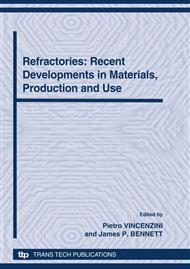p.136
p.141
p.150
p.160
p.167
p.173
p.179
p.193
p.199
Simulation of Moulding of Refractory Bricks
Abstract:
Simulations presented here aim to show reasons for undesirable product heterogeneity and possible defects. Potential negative influences are for example insufficient deaeration, friction between the bulk material and the mould, deformation of the mould and an inappropriate mould filling. In a first step data were collected from a production process. This includes the load and displacement during moulding and the mass of the mix filled into the mould. For the Finite Element modelling with ABAQUS the brick material was simulated with a Drucker-Prager model including a cap. The results show the influence of the friction between mix and mould on the densities and stresses in the pressed blank.
Info:
Periodical:
Pages:
167-172
Citation:
Online since:
October 2010
Authors:
Price:
Сopyright:
© 2010 Trans Tech Publications Ltd. All Rights Reserved
Share:
Citation:


